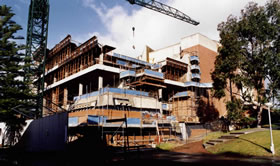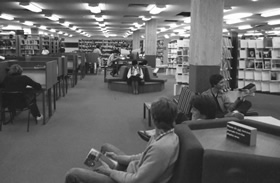
 Extensions to Robertson Library under construction, 1989-1991.
Extensions to Robertson Library under construction, 1989-1991.
 Level five of the Library in the early 1980s showing the microfiche catalogue in use, the current journal area with comfortable lounge style seating and carrels for individual study.
Level five of the Library in the early 1980s showing the microfiche catalogue in use, the current journal area with comfortable lounge style seating and carrels for individual study.
 |
||||||||||||||||||||||||||||||||||||||||||||||||||||
| Endnotes | ||||||||||||||||||||||||||||||||||||||||||||||||||||
| 1. Allen, G G, 2012, WAIT/Curtin Library highlights, [Personal communication] | Back |
|
||||||||||||||||||||||||||||||||||||||||||||||||||
| 2. BPO (Business Periodicals on Disc) was an indexing database for business resources. | Back | |||||||||||||||||||||||||||||||||||||||||||||||||||
| 3. White, Michael, 1996, WAIT to Curtin: A history of the Western Australian Institute of Technology, Paradigm Books: Curtin University, p 223. | Back | |||||||||||||||||||||||||||||||||||||||||||||||||||
| 4. An arcade ran through the middle of the stage one building’s entrance level, providing access to the coffee shop, library administration and student lockers without the need to enter the reading room space, which had a turnstile entry and exit. | Back | |||||||||||||||||||||||||||||||||||||||||||||||||||
| 5. The three entries meant that the Library was accessible from most parts of the campus and effectively had no back or front. | Back | |||||||||||||||||||||||||||||||||||||||||||||||||||
| 6. Allen, G G, c 1993, ‘How not to build a university library, or the tragical historie of Dr Robertson’s Library’, [unpublished draft, Curtin University Library internal document] | Back | |||||||||||||||||||||||||||||||||||||||||||||||||||
| 7. In 1982 this meant an overall rise for the Library of about 14% in the price of books and 30% in the cost of journal subscriptions. | Back | |||||||||||||||||||||||||||||||||||||||||||||||||||
| 8. Subscriptions had increased by some 15% for a number of consecutive years resulting in various journals have been cancelled over the years. | Back | |||||||||||||||||||||||||||||||||||||||||||||||||||
| 9. In September 1988, a record 3,600 recommendations for book purchases were submitted, a record for this decade. | Back | |||||||||||||||||||||||||||||||||||||||||||||||||||
| 10. Allen, G G, 1990, ‘A brief history of the WAIT Library’, In Allen, G G and Zoll, I (Eds) Coming of age in librarianship: A festschrift for the 21st birthday of the WAIT Library, Perth, Curtin University of Technology, (Western Library Studies 14) (p 59) | Back | |||||||||||||||||||||||||||||||||||||||||||||||||||
| 11. Previously, many of these were only available through local network arrangements or via dial-up access. For example, library collections across the country can be searched via AARNET using the National Library of Australia’s Australian Bibliographic Network (ABN). | Back | |||||||||||||||||||||||||||||||||||||||||||||||||||
| 12. The barcode labels containing book and borrower numbers were produced by an outside firm using magnetic tapes with data from the Library's master file. The labels were put on books as they were returned from loan and by teams working their way systematically through the collection on the shelves. | Back | |||||||||||||||||||||||||||||||||||||||||||||||||||
| 13. The State Library and the three Western Australian tertiary libraries’ catalogues were accessible via the Linked Library Network. | Back | |||||||||||||||||||||||||||||||||||||||||||||||||||
| 14. For any one search, terms could be combined - for example, the title could be combined with the author, or the subject with the author. | Back | |||||||||||||||||||||||||||||||||||||||||||||||||||
| 15. White, Michael, 1996, WAIT to Curtin: A history of the Western Australian Institute of Technology, Paradigm Books: Curtin University, p 223 | Back | |||||||||||||||||||||||||||||||||||||||||||||||||||
| 16. Allen, G G, 2012, WAIT/Curtin Library highlights [Personal communication] | Back | |||||||||||||||||||||||||||||||||||||||||||||||||||
| 17. A listing of all substantial publications by staff was included in the Library’s annual reports for the 25 years of Allen’s leadership. | Back | |||||||||||||||||||||||||||||||||||||||||||||||||||
| 18. For example, issue 12 from 1990 was ‘Library activity survey of tertiary nursing students in WA’ by L Hastings while issue 13 from the same year was ‘Libraries in universities of technology’ by G G Allen and Helen Dawes. | Back | |||||||||||||||||||||||||||||||||||||||||||||||||||